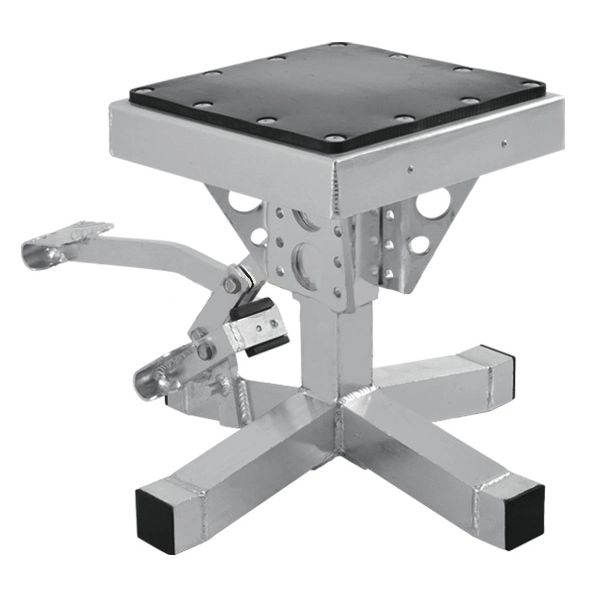Understanding the Basics: Motorcycle Lift Stands and Hydraulic Lifts
Defining Motorcycle Lift Stands
A motorcycle lift stand is a mechanical device designed to elevate a motorcycle off the ground, providing easy access for maintenance, repairs, or storage. These stands typically use a lever or scissor mechanism to raise the bike, and they come in various styles, including center stands, paddock stands, and scissor lifts. Motorcycle lift stands are prized for their simplicity, portability, and affordability, making them a popular choice among enthusiasts and home mechanics.
Exploring Hydraulic Lifts
Hydraulic motorcycle stand lift, as the name suggests, utilizes hydraulic pressure to lift motorcycles. These systems consist of a platform, hydraulic cylinder, and pump mechanism. By applying pressure to the hydraulic fluid, the lift can raise heavy loads with minimal effort. Hydraulic lifts are known for their stability, high weight capacity, and smooth operation, making them a staple in professional motorcycle repair shops and dealerships.
Basic Operating Principles
While both types of lifts serve the same primary purpose, their operating principles differ significantly. Motorcycle lift stands rely on mechanical advantage, using levers or scissor mechanisms to multiply the user's input force. In contrast, hydraulic lifts harness the power of fluid dynamics, using incompressible liquids to transmit force and lift heavy loads with ease. Understanding these fundamental differences is crucial when considering which option best suits your needs.
Comparing Features: Motorcycle Lift Stands vs Hydraulic Lifts
Portability and Space Requirements
One of the most significant advantages of motorcycle lift stands is their portability. These compact devices can be easily moved around the garage or workshop, and many models can be folded for storage when not in use. This makes them ideal for home mechanics with limited space or those who need to work on their bikes in different locations. Hydraulic lifts, while more powerful, are generally stationary and require a dedicated space in your workshop. Their larger footprint and weight make them less suitable for those with space constraints or the need for mobility.
Lifting Capacity and Stability
When it comes to lifting capacity, hydraulic lifts typically have the upper hand. These systems can handle heavier motorcycles and provide a more stable platform for working on larger bikes or performing extensive repairs. Motorcycle lift stands, while capable of supporting most standard motorcycles, may have limitations when it comes to extremely heavy or oddly-shaped bikes. However, many high-quality motorcycle stand lifts are designed with safety features and robust construction to ensure stability during use.
Versatility and Adjustability
Hydraulic lifts often offer greater versatility in terms of adjustable height settings and working positions. This allows mechanics to find the optimal height for different tasks and bike models. Some hydraulic lifts also come with additional features like tilting platforms or side extensions for enhanced accessibility. Motorcycle lift stands, while more limited in their adjustability, often come in specialized designs for specific tasks, such as rear wheel lifts for chain maintenance or front fork stands for suspension work.
Making the Right Choice: Factors to Consider
Assessing Your Needs and Budget
Choosing between a motorcycle lift stand and a hydraulic lift ultimately comes down to your specific needs and budget. Consider the types of motorcycles you'll be working on, the frequency of use, and the available space in your workshop. Motorcycle lift stands are generally more affordable and suitable for occasional use or smaller bikes, while hydraulic lifts represent a larger investment but offer more capabilities for frequent or professional use.
Evaluating Your Workspace
Take a close look at your workspace when making your decision. If you have a dedicated workshop with ample floor space, a hydraulic lift might be a worthwhile investment. However, if you're working in a shared garage or need the flexibility to move your equipment, a motorcycle lift stand could be the better choice. Consider factors like power availability, floor surface, and ceiling height when evaluating your options.
Long-term Considerations
Think about your long-term plans when selecting a lift solution. If you're planning to expand your motorcycle maintenance activities or potentially work on a wider range of bikes in the future, investing in a more versatile hydraulic lift might be prudent. On the other hand, if you're primarily focused on maintaining your personal motorcycle collection, a high-quality motorcycle lift stand could serve you well for years to come. Consider factors like durability, warranty, and potential resale value when making your decision.
Conclusion
Choosing between a motorcycle lift stand and a hydraulic lift depends on various factors, including your specific needs, available space, and budget. Motorcycle lift stands offer portability, affordability, and ease of use, making them ideal for home mechanics and enthusiasts. Hydraulic lifts provide greater stability, lifting capacity, and versatility, suiting professional environments and heavy-duty applications. By carefully considering your requirements and evaluating the features of each option, you can make an informed decision that will enhance your motorcycle maintenance capabilities and improve your overall working experience.
Contact Us
Ready to elevate your motorcycle maintenance game? For expert advice on choosing the perfect lift solution for your needs, contact RUNVA ENTERPRISES LIMITED at info@runva.com.cn. Our team of specialists is here to help you find the ideal motorcycle lift stand or hydraulic lift to suit your specific requirements.

_1737625693698.webp)


